Australian Math Curriculum: Development, Resources and Engagement
VerifiedAdded on 2023/06/03
|10
|2920
|308
Report
AI Summary
This report delves into the development of the mathematics curriculum within the Australian education system, focusing on primary levels (Years K-6, 7-10, and 11-12). It examines mathematical concepts taught at different stages, such as numbers and algebra in early years, geometry and measurements in middle years, and statistics and probability in upper years. The report highlights the importance of algebra as a foundational subject and discusses how geometry is crucial for careers like architecture and computer animation. Furthermore, it emphasizes the role of statistics and probability in decision-making and data representation. The report also explores the use of ICT resources like multimedia and e-learning sites to enhance student engagement and learning, alongside the value of inviting local experts and conducting field trips to provide real-world context to mathematical concepts.
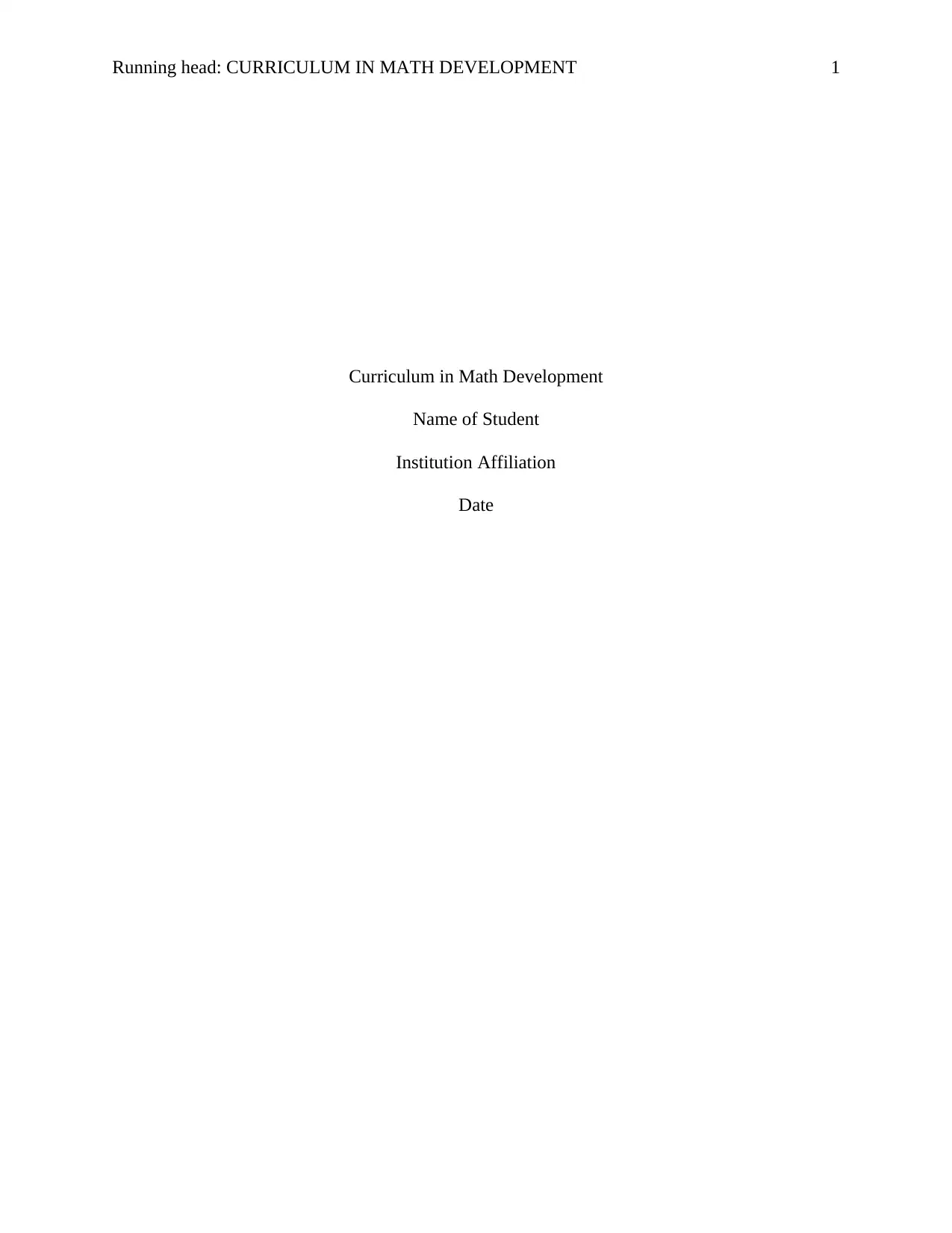
Running head: CURRICULUM IN MATH DEVELOPMENT 1
Curriculum in Math Development
Name of Student
Institution Affiliation
Date
Curriculum in Math Development
Name of Student
Institution Affiliation
Date
Paraphrase This Document
Need a fresh take? Get an instant paraphrase of this document with our AI Paraphraser

CURRICULUM IN MATH DEVELOPMENT 2
Curriculum in Math Development
An academic curriculum is designed to equip the learners to learn from the skills taught in
a way they will be able to apply the taught skill in a real life situation or in the advancement of a
certain concept later in life (Clark, & Mayer, 2016). The paper’s main focus will be on the
various Australian academic levels, a brief description of the mathematical concepts taught in the
various primary levels, the examples of resources used in the development of mathematics
among the students and a rationalization of how each of the resources enhances student learning
and engagement in the content taught.
The obvious reason to create a future oriented curriculum provides an opportunity for
improved and intensive teaching methods. It is evident that the future’s society will be
multifarious and competitive; so as to ensure that the future inhabitants of that society thrive
well, the change that will change the future will have to begin from the present times (Atweh, &
Goos, 2011).
The aims of the Australian mathematics curriculum include educating young Australian
citizens, enhance their activeness and incorporate mathematical concepts in the ways they predict
future events such as financial planning and make personal decisions. Math learning also
enhances and enriches the learning of other subjects and concepts that may include in other
learning disciplines. It is also designed to change the way of thinking of citizens (Whitin, &
Wilde, 2015). Once the citizens are able to think in a mathematical manner, they are able to
come up with accurate future and problem-solving plans that will greatly impact on the
development of the nation as a whole. Moreover, math has its own beauty once understood and it
is intended that every learner will appreciate the role mathematics plays in improving their ways
of thinking.
Curriculum in Math Development
An academic curriculum is designed to equip the learners to learn from the skills taught in
a way they will be able to apply the taught skill in a real life situation or in the advancement of a
certain concept later in life (Clark, & Mayer, 2016). The paper’s main focus will be on the
various Australian academic levels, a brief description of the mathematical concepts taught in the
various primary levels, the examples of resources used in the development of mathematics
among the students and a rationalization of how each of the resources enhances student learning
and engagement in the content taught.
The obvious reason to create a future oriented curriculum provides an opportunity for
improved and intensive teaching methods. It is evident that the future’s society will be
multifarious and competitive; so as to ensure that the future inhabitants of that society thrive
well, the change that will change the future will have to begin from the present times (Atweh, &
Goos, 2011).
The aims of the Australian mathematics curriculum include educating young Australian
citizens, enhance their activeness and incorporate mathematical concepts in the ways they predict
future events such as financial planning and make personal decisions. Math learning also
enhances and enriches the learning of other subjects and concepts that may include in other
learning disciplines. It is also designed to change the way of thinking of citizens (Whitin, &
Wilde, 2015). Once the citizens are able to think in a mathematical manner, they are able to
come up with accurate future and problem-solving plans that will greatly impact on the
development of the nation as a whole. Moreover, math has its own beauty once understood and it
is intended that every learner will appreciate the role mathematics plays in improving their ways
of thinking.
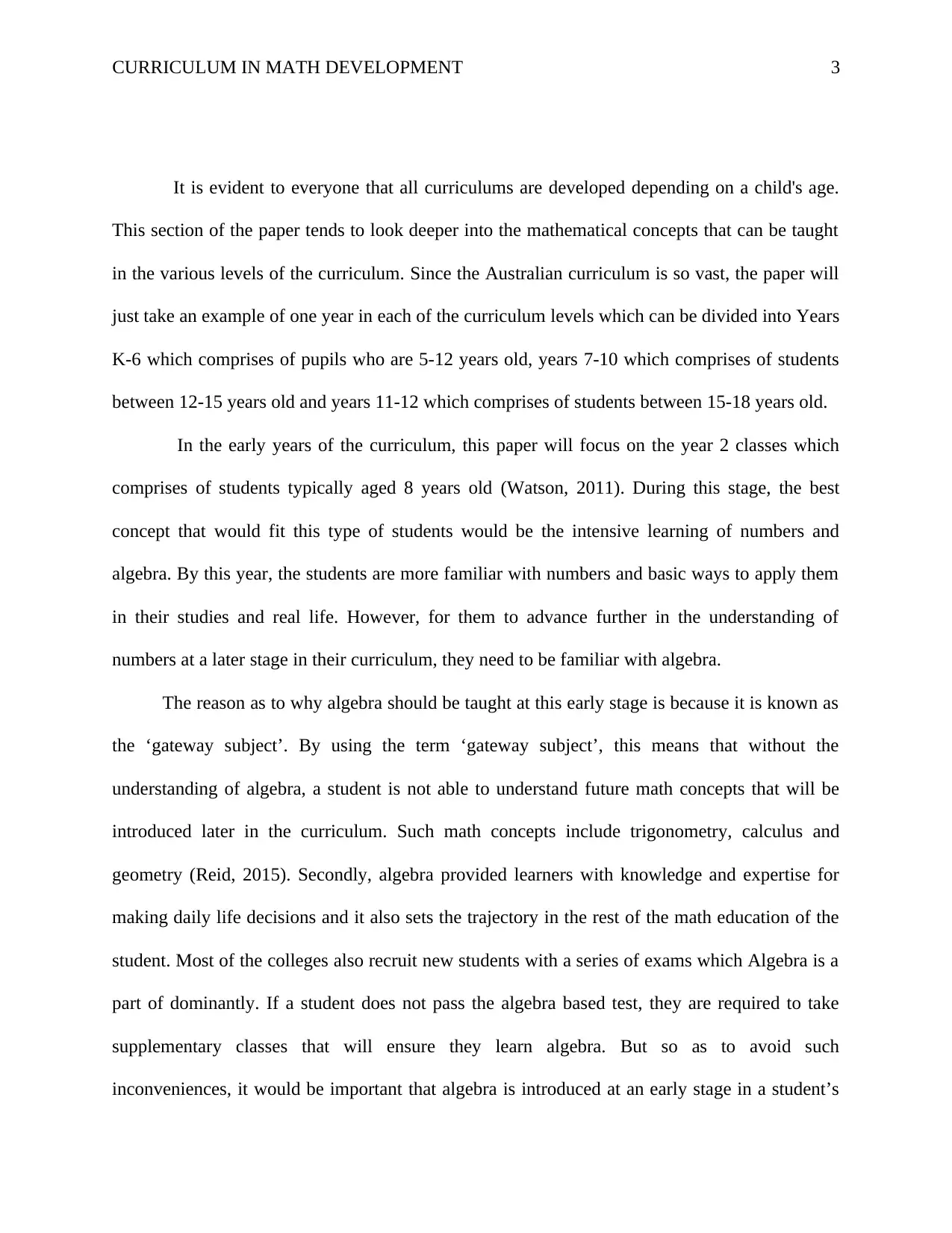
CURRICULUM IN MATH DEVELOPMENT 3
It is evident to everyone that all curriculums are developed depending on a child's age.
This section of the paper tends to look deeper into the mathematical concepts that can be taught
in the various levels of the curriculum. Since the Australian curriculum is so vast, the paper will
just take an example of one year in each of the curriculum levels which can be divided into Years
K-6 which comprises of pupils who are 5-12 years old, years 7-10 which comprises of students
between 12-15 years old and years 11-12 which comprises of students between 15-18 years old.
In the early years of the curriculum, this paper will focus on the year 2 classes which
comprises of students typically aged 8 years old (Watson, 2011). During this stage, the best
concept that would fit this type of students would be the intensive learning of numbers and
algebra. By this year, the students are more familiar with numbers and basic ways to apply them
in their studies and real life. However, for them to advance further in the understanding of
numbers at a later stage in their curriculum, they need to be familiar with algebra.
The reason as to why algebra should be taught at this early stage is because it is known as
the ‘gateway subject’. By using the term ‘gateway subject’, this means that without the
understanding of algebra, a student is not able to understand future math concepts that will be
introduced later in the curriculum. Such math concepts include trigonometry, calculus and
geometry (Reid, 2015). Secondly, algebra provided learners with knowledge and expertise for
making daily life decisions and it also sets the trajectory in the rest of the math education of the
student. Most of the colleges also recruit new students with a series of exams which Algebra is a
part of dominantly. If a student does not pass the algebra based test, they are required to take
supplementary classes that will ensure they learn algebra. But so as to avoid such
inconveniences, it would be important that algebra is introduced at an early stage in a student’s
It is evident to everyone that all curriculums are developed depending on a child's age.
This section of the paper tends to look deeper into the mathematical concepts that can be taught
in the various levels of the curriculum. Since the Australian curriculum is so vast, the paper will
just take an example of one year in each of the curriculum levels which can be divided into Years
K-6 which comprises of pupils who are 5-12 years old, years 7-10 which comprises of students
between 12-15 years old and years 11-12 which comprises of students between 15-18 years old.
In the early years of the curriculum, this paper will focus on the year 2 classes which
comprises of students typically aged 8 years old (Watson, 2011). During this stage, the best
concept that would fit this type of students would be the intensive learning of numbers and
algebra. By this year, the students are more familiar with numbers and basic ways to apply them
in their studies and real life. However, for them to advance further in the understanding of
numbers at a later stage in their curriculum, they need to be familiar with algebra.
The reason as to why algebra should be taught at this early stage is because it is known as
the ‘gateway subject’. By using the term ‘gateway subject’, this means that without the
understanding of algebra, a student is not able to understand future math concepts that will be
introduced later in the curriculum. Such math concepts include trigonometry, calculus and
geometry (Reid, 2015). Secondly, algebra provided learners with knowledge and expertise for
making daily life decisions and it also sets the trajectory in the rest of the math education of the
student. Most of the colleges also recruit new students with a series of exams which Algebra is a
part of dominantly. If a student does not pass the algebra based test, they are required to take
supplementary classes that will ensure they learn algebra. But so as to avoid such
inconveniences, it would be important that algebra is introduced at an early stage in a student’s
⊘ This is a preview!⊘
Do you want full access?
Subscribe today to unlock all pages.

Trusted by 1+ million students worldwide
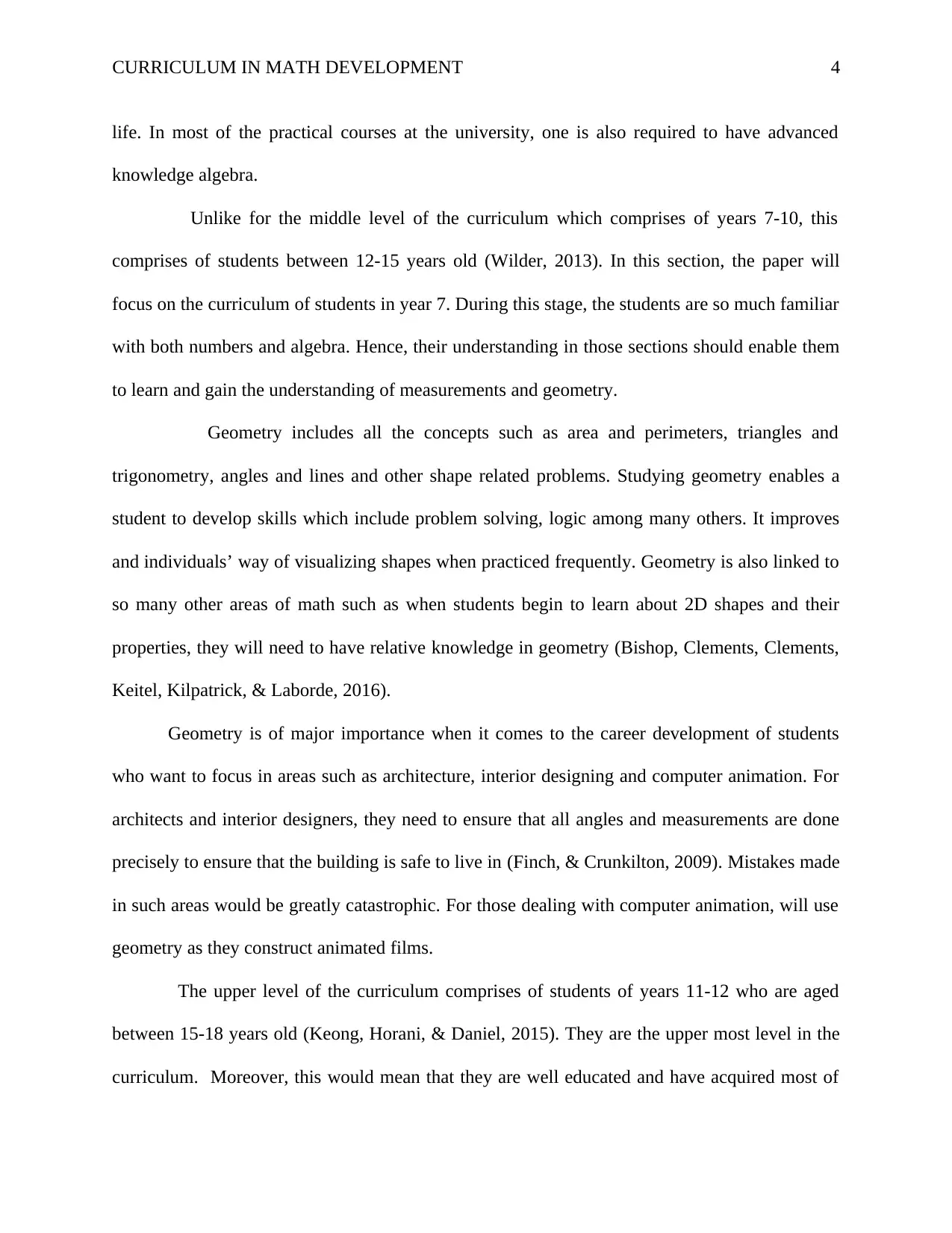
CURRICULUM IN MATH DEVELOPMENT 4
life. In most of the practical courses at the university, one is also required to have advanced
knowledge algebra.
Unlike for the middle level of the curriculum which comprises of years 7-10, this
comprises of students between 12-15 years old (Wilder, 2013). In this section, the paper will
focus on the curriculum of students in year 7. During this stage, the students are so much familiar
with both numbers and algebra. Hence, their understanding in those sections should enable them
to learn and gain the understanding of measurements and geometry.
Geometry includes all the concepts such as area and perimeters, triangles and
trigonometry, angles and lines and other shape related problems. Studying geometry enables a
student to develop skills which include problem solving, logic among many others. It improves
and individuals’ way of visualizing shapes when practiced frequently. Geometry is also linked to
so many other areas of math such as when students begin to learn about 2D shapes and their
properties, they will need to have relative knowledge in geometry (Bishop, Clements, Clements,
Keitel, Kilpatrick, & Laborde, 2016).
Geometry is of major importance when it comes to the career development of students
who want to focus in areas such as architecture, interior designing and computer animation. For
architects and interior designers, they need to ensure that all angles and measurements are done
precisely to ensure that the building is safe to live in (Finch, & Crunkilton, 2009). Mistakes made
in such areas would be greatly catastrophic. For those dealing with computer animation, will use
geometry as they construct animated films.
The upper level of the curriculum comprises of students of years 11-12 who are aged
between 15-18 years old (Keong, Horani, & Daniel, 2015). They are the upper most level in the
curriculum. Moreover, this would mean that they are well educated and have acquired most of
life. In most of the practical courses at the university, one is also required to have advanced
knowledge algebra.
Unlike for the middle level of the curriculum which comprises of years 7-10, this
comprises of students between 12-15 years old (Wilder, 2013). In this section, the paper will
focus on the curriculum of students in year 7. During this stage, the students are so much familiar
with both numbers and algebra. Hence, their understanding in those sections should enable them
to learn and gain the understanding of measurements and geometry.
Geometry includes all the concepts such as area and perimeters, triangles and
trigonometry, angles and lines and other shape related problems. Studying geometry enables a
student to develop skills which include problem solving, logic among many others. It improves
and individuals’ way of visualizing shapes when practiced frequently. Geometry is also linked to
so many other areas of math such as when students begin to learn about 2D shapes and their
properties, they will need to have relative knowledge in geometry (Bishop, Clements, Clements,
Keitel, Kilpatrick, & Laborde, 2016).
Geometry is of major importance when it comes to the career development of students
who want to focus in areas such as architecture, interior designing and computer animation. For
architects and interior designers, they need to ensure that all angles and measurements are done
precisely to ensure that the building is safe to live in (Finch, & Crunkilton, 2009). Mistakes made
in such areas would be greatly catastrophic. For those dealing with computer animation, will use
geometry as they construct animated films.
The upper level of the curriculum comprises of students of years 11-12 who are aged
between 15-18 years old (Keong, Horani, & Daniel, 2015). They are the upper most level in the
curriculum. Moreover, this would mean that they are well educated and have acquired most of
Paraphrase This Document
Need a fresh take? Get an instant paraphrase of this document with our AI Paraphraser
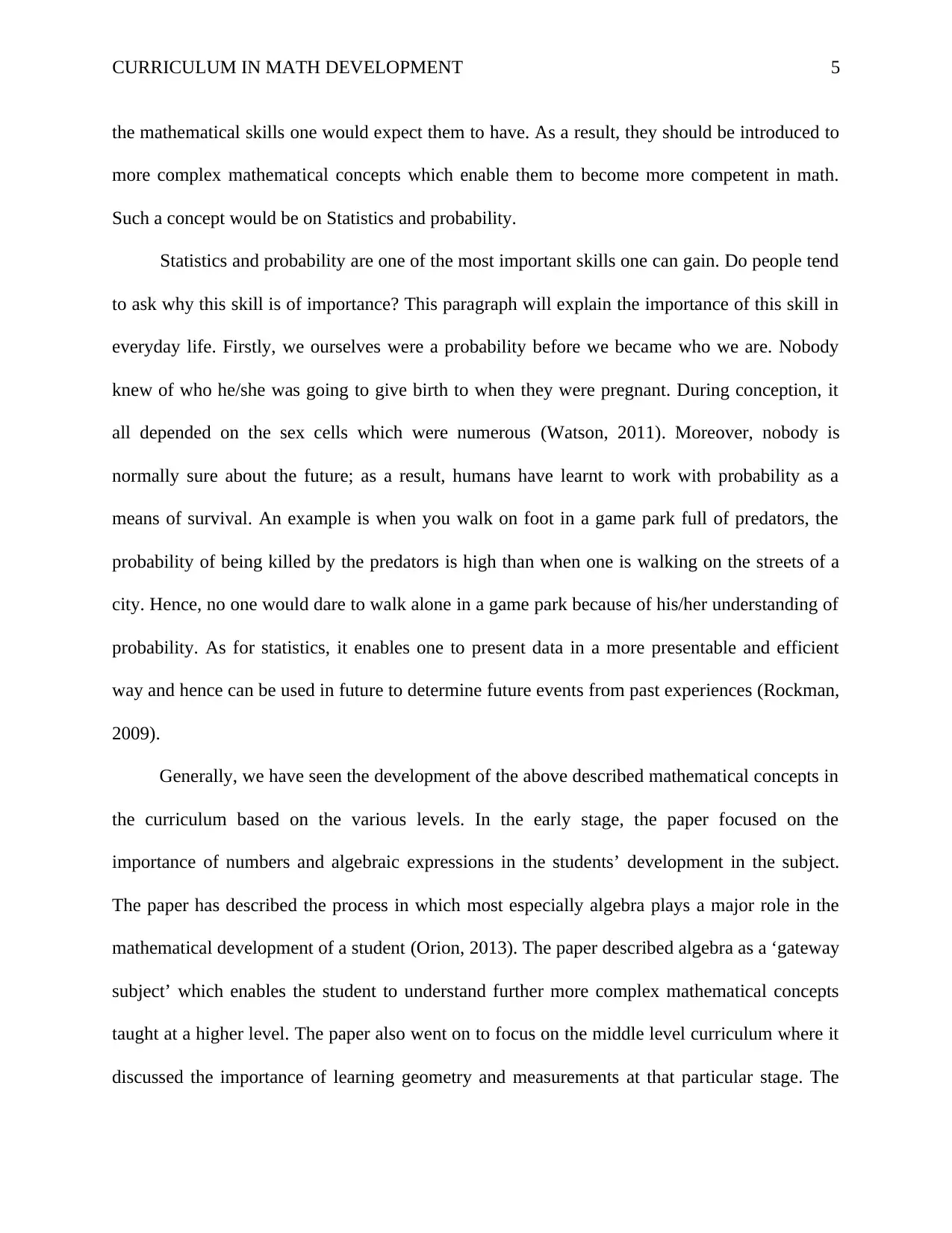
CURRICULUM IN MATH DEVELOPMENT 5
the mathematical skills one would expect them to have. As a result, they should be introduced to
more complex mathematical concepts which enable them to become more competent in math.
Such a concept would be on Statistics and probability.
Statistics and probability are one of the most important skills one can gain. Do people tend
to ask why this skill is of importance? This paragraph will explain the importance of this skill in
everyday life. Firstly, we ourselves were a probability before we became who we are. Nobody
knew of who he/she was going to give birth to when they were pregnant. During conception, it
all depended on the sex cells which were numerous (Watson, 2011). Moreover, nobody is
normally sure about the future; as a result, humans have learnt to work with probability as a
means of survival. An example is when you walk on foot in a game park full of predators, the
probability of being killed by the predators is high than when one is walking on the streets of a
city. Hence, no one would dare to walk alone in a game park because of his/her understanding of
probability. As for statistics, it enables one to present data in a more presentable and efficient
way and hence can be used in future to determine future events from past experiences (Rockman,
2009).
Generally, we have seen the development of the above described mathematical concepts in
the curriculum based on the various levels. In the early stage, the paper focused on the
importance of numbers and algebraic expressions in the students’ development in the subject.
The paper has described the process in which most especially algebra plays a major role in the
mathematical development of a student (Orion, 2013). The paper described algebra as a ‘gateway
subject’ which enables the student to understand further more complex mathematical concepts
taught at a higher level. The paper also went on to focus on the middle level curriculum where it
discussed the importance of learning geometry and measurements at that particular stage. The
the mathematical skills one would expect them to have. As a result, they should be introduced to
more complex mathematical concepts which enable them to become more competent in math.
Such a concept would be on Statistics and probability.
Statistics and probability are one of the most important skills one can gain. Do people tend
to ask why this skill is of importance? This paragraph will explain the importance of this skill in
everyday life. Firstly, we ourselves were a probability before we became who we are. Nobody
knew of who he/she was going to give birth to when they were pregnant. During conception, it
all depended on the sex cells which were numerous (Watson, 2011). Moreover, nobody is
normally sure about the future; as a result, humans have learnt to work with probability as a
means of survival. An example is when you walk on foot in a game park full of predators, the
probability of being killed by the predators is high than when one is walking on the streets of a
city. Hence, no one would dare to walk alone in a game park because of his/her understanding of
probability. As for statistics, it enables one to present data in a more presentable and efficient
way and hence can be used in future to determine future events from past experiences (Rockman,
2009).
Generally, we have seen the development of the above described mathematical concepts in
the curriculum based on the various levels. In the early stage, the paper focused on the
importance of numbers and algebraic expressions in the students’ development in the subject.
The paper has described the process in which most especially algebra plays a major role in the
mathematical development of a student (Orion, 2013). The paper described algebra as a ‘gateway
subject’ which enables the student to understand further more complex mathematical concepts
taught at a higher level. The paper also went on to focus on the middle level curriculum where it
discussed the importance of learning geometry and measurements at that particular stage. The
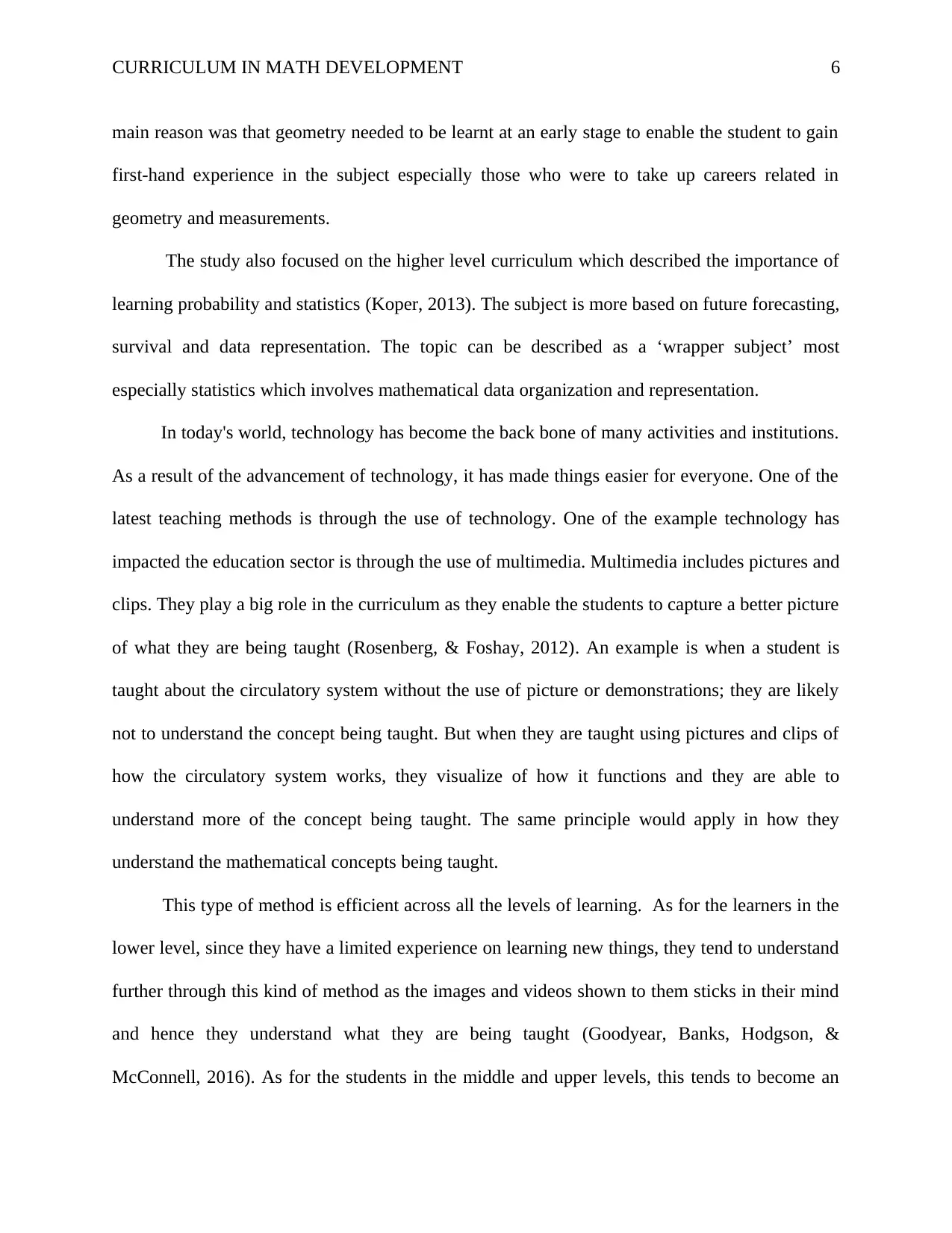
CURRICULUM IN MATH DEVELOPMENT 6
main reason was that geometry needed to be learnt at an early stage to enable the student to gain
first-hand experience in the subject especially those who were to take up careers related in
geometry and measurements.
The study also focused on the higher level curriculum which described the importance of
learning probability and statistics (Koper, 2013). The subject is more based on future forecasting,
survival and data representation. The topic can be described as a ‘wrapper subject’ most
especially statistics which involves mathematical data organization and representation.
In today's world, technology has become the back bone of many activities and institutions.
As a result of the advancement of technology, it has made things easier for everyone. One of the
latest teaching methods is through the use of technology. One of the example technology has
impacted the education sector is through the use of multimedia. Multimedia includes pictures and
clips. They play a big role in the curriculum as they enable the students to capture a better picture
of what they are being taught (Rosenberg, & Foshay, 2012). An example is when a student is
taught about the circulatory system without the use of picture or demonstrations; they are likely
not to understand the concept being taught. But when they are taught using pictures and clips of
how the circulatory system works, they visualize of how it functions and they are able to
understand more of the concept being taught. The same principle would apply in how they
understand the mathematical concepts being taught.
This type of method is efficient across all the levels of learning. As for the learners in the
lower level, since they have a limited experience on learning new things, they tend to understand
further through this kind of method as the images and videos shown to them sticks in their mind
and hence they understand what they are being taught (Goodyear, Banks, Hodgson, &
McConnell, 2016). As for the students in the middle and upper levels, this tends to become an
main reason was that geometry needed to be learnt at an early stage to enable the student to gain
first-hand experience in the subject especially those who were to take up careers related in
geometry and measurements.
The study also focused on the higher level curriculum which described the importance of
learning probability and statistics (Koper, 2013). The subject is more based on future forecasting,
survival and data representation. The topic can be described as a ‘wrapper subject’ most
especially statistics which involves mathematical data organization and representation.
In today's world, technology has become the back bone of many activities and institutions.
As a result of the advancement of technology, it has made things easier for everyone. One of the
latest teaching methods is through the use of technology. One of the example technology has
impacted the education sector is through the use of multimedia. Multimedia includes pictures and
clips. They play a big role in the curriculum as they enable the students to capture a better picture
of what they are being taught (Rosenberg, & Foshay, 2012). An example is when a student is
taught about the circulatory system without the use of picture or demonstrations; they are likely
not to understand the concept being taught. But when they are taught using pictures and clips of
how the circulatory system works, they visualize of how it functions and they are able to
understand more of the concept being taught. The same principle would apply in how they
understand the mathematical concepts being taught.
This type of method is efficient across all the levels of learning. As for the learners in the
lower level, since they have a limited experience on learning new things, they tend to understand
further through this kind of method as the images and videos shown to them sticks in their mind
and hence they understand what they are being taught (Goodyear, Banks, Hodgson, &
McConnell, 2016). As for the students in the middle and upper levels, this tends to become an
⊘ This is a preview!⊘
Do you want full access?
Subscribe today to unlock all pages.

Trusted by 1+ million students worldwide

CURRICULUM IN MATH DEVELOPMENT 7
effective mode of learning most especially where they are introduced to completely new
concepts that they don’t have an understanding of. This can also be used to enable them to
remember of the concepts taught in class. It is also widely used when complex concepts are
introduced, ones which they are not familiar with.
Another ICT resource that could be used in the math curriculum development of the
students would include the use of e-learning sites. E-learning sites are normally a meeting point
of the teachers and students at an individual and corporate level. The teacher is able to post the
various learning materials students require such as notes and past papers. The most important
value incorporated by the e-learning system is consistency (Higgins, 2013). This is as a student is
able to track his or her personal development using the site. The teacher is also able to check on
the progress of each and every individual student and also the class as a whole. This ensures that
both the teachers and most especially the students become responsible and accountable for their
progress.
Thirdly, another resource that can be used in the enhancement of learning would be the
invitation of local experts and carrying out of field trips. Invitation of experts in a classroom
setting makes the student’s learning become more interactive and they are able to relate with the
reality of the mathematical concepts being taught in class (Orion, & Hofstein, 2011). An expert
also poses extra knowledge which the teacher doesn’t have; hence he/she may impart some great
understanding and knowledge of the concept hence enhancing the students learning capabilities.
From the analysis it is clear that carrying out of field trips also enhances the students
learning as they are able to visualize and understand the real life applications of the topic that
they are being taught. Hence they are able to understand more of what they are taught in class.
Carrying out field trips also enhances the learning abilities of the student as it makes learning
effective mode of learning most especially where they are introduced to completely new
concepts that they don’t have an understanding of. This can also be used to enable them to
remember of the concepts taught in class. It is also widely used when complex concepts are
introduced, ones which they are not familiar with.
Another ICT resource that could be used in the math curriculum development of the
students would include the use of e-learning sites. E-learning sites are normally a meeting point
of the teachers and students at an individual and corporate level. The teacher is able to post the
various learning materials students require such as notes and past papers. The most important
value incorporated by the e-learning system is consistency (Higgins, 2013). This is as a student is
able to track his or her personal development using the site. The teacher is also able to check on
the progress of each and every individual student and also the class as a whole. This ensures that
both the teachers and most especially the students become responsible and accountable for their
progress.
Thirdly, another resource that can be used in the enhancement of learning would be the
invitation of local experts and carrying out of field trips. Invitation of experts in a classroom
setting makes the student’s learning become more interactive and they are able to relate with the
reality of the mathematical concepts being taught in class (Orion, & Hofstein, 2011). An expert
also poses extra knowledge which the teacher doesn’t have; hence he/she may impart some great
understanding and knowledge of the concept hence enhancing the students learning capabilities.
From the analysis it is clear that carrying out of field trips also enhances the students
learning as they are able to visualize and understand the real life applications of the topic that
they are being taught. Hence they are able to understand more of what they are taught in class.
Carrying out field trips also enhances the learning abilities of the student as it makes learning
Paraphrase This Document
Need a fresh take? Get an instant paraphrase of this document with our AI Paraphraser
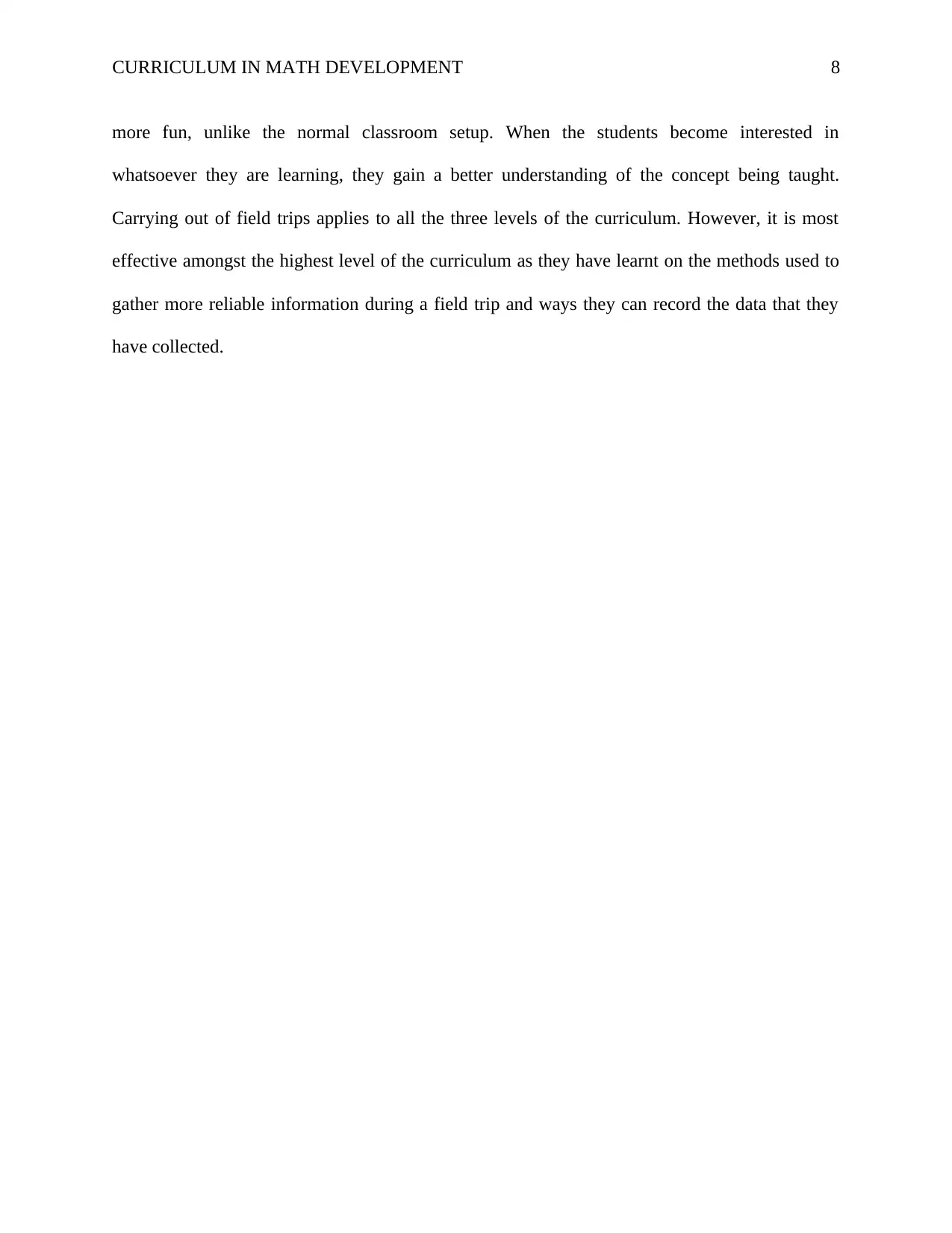
CURRICULUM IN MATH DEVELOPMENT 8
more fun, unlike the normal classroom setup. When the students become interested in
whatsoever they are learning, they gain a better understanding of the concept being taught.
Carrying out of field trips applies to all the three levels of the curriculum. However, it is most
effective amongst the highest level of the curriculum as they have learnt on the methods used to
gather more reliable information during a field trip and ways they can record the data that they
have collected.
more fun, unlike the normal classroom setup. When the students become interested in
whatsoever they are learning, they gain a better understanding of the concept being taught.
Carrying out of field trips applies to all the three levels of the curriculum. However, it is most
effective amongst the highest level of the curriculum as they have learnt on the methods used to
gather more reliable information during a field trip and ways they can record the data that they
have collected.
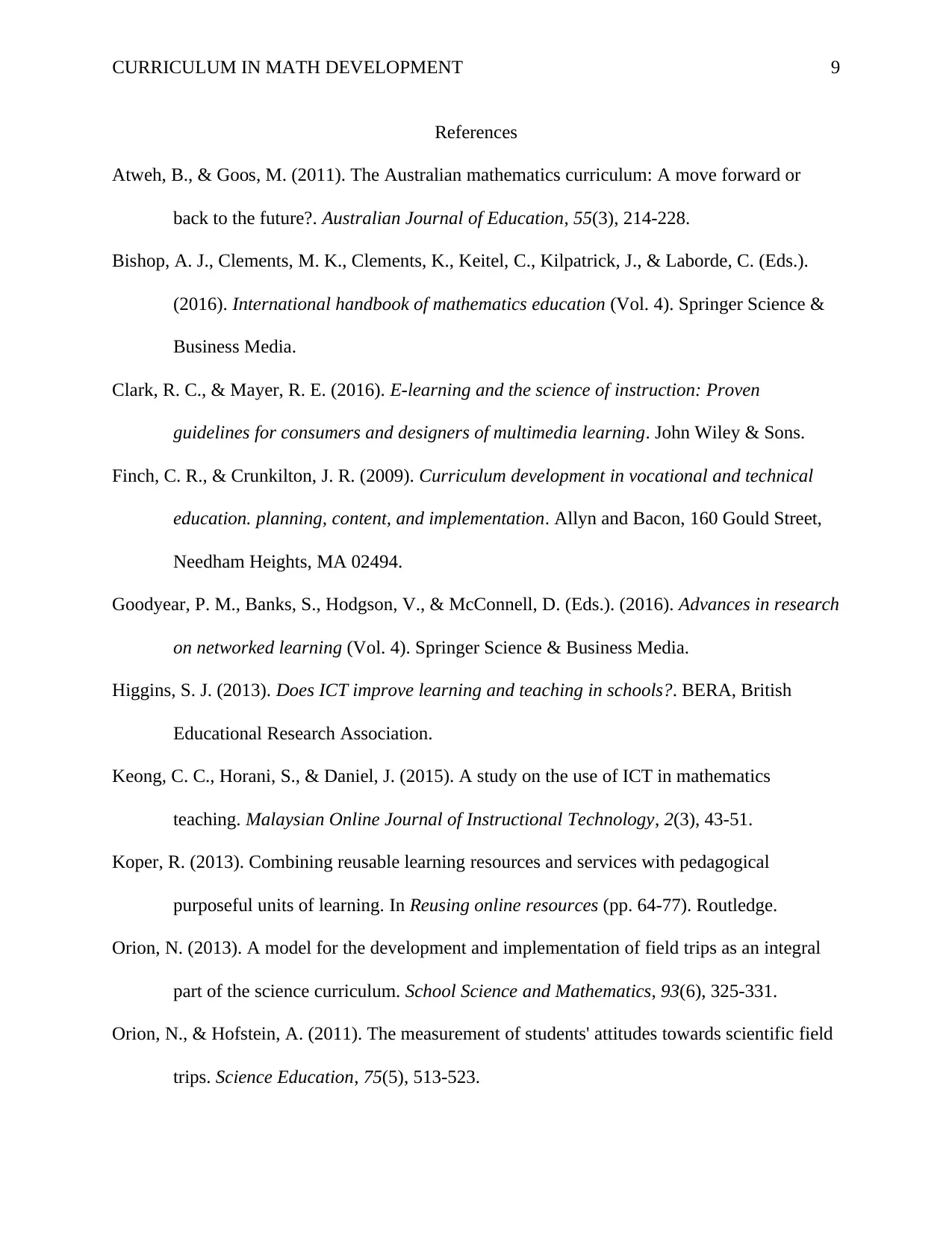
CURRICULUM IN MATH DEVELOPMENT 9
References
Atweh, B., & Goos, M. (2011). The Australian mathematics curriculum: A move forward or
back to the future?. Australian Journal of Education, 55(3), 214-228.
Bishop, A. J., Clements, M. K., Clements, K., Keitel, C., Kilpatrick, J., & Laborde, C. (Eds.).
(2016). International handbook of mathematics education (Vol. 4). Springer Science &
Business Media.
Clark, R. C., & Mayer, R. E. (2016). E-learning and the science of instruction: Proven
guidelines for consumers and designers of multimedia learning. John Wiley & Sons.
Finch, C. R., & Crunkilton, J. R. (2009). Curriculum development in vocational and technical
education. planning, content, and implementation. Allyn and Bacon, 160 Gould Street,
Needham Heights, MA 02494.
Goodyear, P. M., Banks, S., Hodgson, V., & McConnell, D. (Eds.). (2016). Advances in research
on networked learning (Vol. 4). Springer Science & Business Media.
Higgins, S. J. (2013). Does ICT improve learning and teaching in schools?. BERA, British
Educational Research Association.
Keong, C. C., Horani, S., & Daniel, J. (2015). A study on the use of ICT in mathematics
teaching. Malaysian Online Journal of Instructional Technology, 2(3), 43-51.
Koper, R. (2013). Combining reusable learning resources and services with pedagogical
purposeful units of learning. In Reusing online resources (pp. 64-77). Routledge.
Orion, N. (2013). A model for the development and implementation of field trips as an integral
part of the science curriculum. School Science and Mathematics, 93(6), 325-331.
Orion, N., & Hofstein, A. (2011). The measurement of students' attitudes towards scientific field
trips. Science Education, 75(5), 513-523.
References
Atweh, B., & Goos, M. (2011). The Australian mathematics curriculum: A move forward or
back to the future?. Australian Journal of Education, 55(3), 214-228.
Bishop, A. J., Clements, M. K., Clements, K., Keitel, C., Kilpatrick, J., & Laborde, C. (Eds.).
(2016). International handbook of mathematics education (Vol. 4). Springer Science &
Business Media.
Clark, R. C., & Mayer, R. E. (2016). E-learning and the science of instruction: Proven
guidelines for consumers and designers of multimedia learning. John Wiley & Sons.
Finch, C. R., & Crunkilton, J. R. (2009). Curriculum development in vocational and technical
education. planning, content, and implementation. Allyn and Bacon, 160 Gould Street,
Needham Heights, MA 02494.
Goodyear, P. M., Banks, S., Hodgson, V., & McConnell, D. (Eds.). (2016). Advances in research
on networked learning (Vol. 4). Springer Science & Business Media.
Higgins, S. J. (2013). Does ICT improve learning and teaching in schools?. BERA, British
Educational Research Association.
Keong, C. C., Horani, S., & Daniel, J. (2015). A study on the use of ICT in mathematics
teaching. Malaysian Online Journal of Instructional Technology, 2(3), 43-51.
Koper, R. (2013). Combining reusable learning resources and services with pedagogical
purposeful units of learning. In Reusing online resources (pp. 64-77). Routledge.
Orion, N. (2013). A model for the development and implementation of field trips as an integral
part of the science curriculum. School Science and Mathematics, 93(6), 325-331.
Orion, N., & Hofstein, A. (2011). The measurement of students' attitudes towards scientific field
trips. Science Education, 75(5), 513-523.
⊘ This is a preview!⊘
Do you want full access?
Subscribe today to unlock all pages.

Trusted by 1+ million students worldwide

CURRICULUM IN MATH DEVELOPMENT 10
Reid, A. (2015). Rethinking national curriculum collaboration: Towards an Australian
curriculum.
Rockman, I. F. (2009). Integrating information literacy into the higher education curriculum:
Practical models for transformation. Jossey-Bass,
Rosenberg, M. J., & Foshay, R. (2012). E‐learning: Strategies for delivering knowledge in the
digital age. Performance Improvement, 41(5), 50-51.
Watson, D. M. (2011). Pedagogy before technology: Re-thinking the relationship between ICT
and teaching. Education and Information technologies, 6(4), 251-266.
Whitin, D. J., & Wilde, S. (2015). It's the Story That Counts: More Children's Books for
Mathematical Learning, K-6. Heinemann, 361 Hanover St., Portsmouth, NH 03801-
3912.
Wilder, R. L. (2013). Evolution of mathematical concepts: An elementary study. Courier
Corporation.
Reid, A. (2015). Rethinking national curriculum collaboration: Towards an Australian
curriculum.
Rockman, I. F. (2009). Integrating information literacy into the higher education curriculum:
Practical models for transformation. Jossey-Bass,
Rosenberg, M. J., & Foshay, R. (2012). E‐learning: Strategies for delivering knowledge in the
digital age. Performance Improvement, 41(5), 50-51.
Watson, D. M. (2011). Pedagogy before technology: Re-thinking the relationship between ICT
and teaching. Education and Information technologies, 6(4), 251-266.
Whitin, D. J., & Wilde, S. (2015). It's the Story That Counts: More Children's Books for
Mathematical Learning, K-6. Heinemann, 361 Hanover St., Portsmouth, NH 03801-
3912.
Wilder, R. L. (2013). Evolution of mathematical concepts: An elementary study. Courier
Corporation.
1 out of 10
Related Documents
Your All-in-One AI-Powered Toolkit for Academic Success.
+13062052269
info@desklib.com
Available 24*7 on WhatsApp / Email
![[object Object]](/_next/static/media/star-bottom.7253800d.svg)
Unlock your academic potential
Copyright © 2020–2025 A2Z Services. All Rights Reserved. Developed and managed by ZUCOL.





